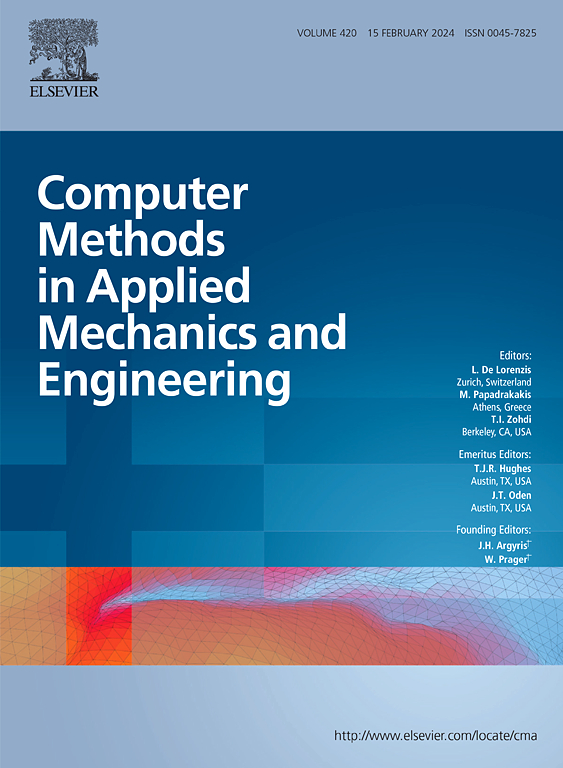Non-overlapping, Schwarz-type domain decomposition method for physics and equality constrained artificial neural networks
IF 6.9
1区 工程技术
Q1 ENGINEERING, MULTIDISCIPLINARY
Computer Methods in Applied Mechanics and Engineering
Pub Date : 2024-12-31
DOI:10.1016/j.cma.2024.117706
引用次数: 0
Abstract
We present a non-overlapping, Schwarz-type domain decomposition method with a generalized interface condition, designed for physics-informed machine learning of partial differential equations (PDEs) in both forward and inverse contexts. Our approach employs physics and equality-constrained artificial neural networks (PECANN) within each subdomain. Unlike the original PECANN method, which relies solely on initial and boundary conditions to constrain PDEs, our method uses both boundary conditions and the governing PDE to constrain a unique interface loss function for each subdomain. This modification improves the learning of subdomain-specific interface parameters while reducing communication overhead by delaying information exchange between neighboring subdomains. To address the constrained optimization in each subdomain, we apply an augmented Lagrangian method with a conditionally adaptive update strategy, transforming the problem into an unconstrained dual optimization. A distinct advantage of our domain decomposition method is its ability to learn solutions to both Poisson’s and Helmholtz equations, even in cases with high-wavenumber and complex-valued solutions. Through numerical experiments with up to 64 subdomains, we demonstrate that our method consistently generalizes well as the number of subdomains increases.
物理约束人工神经网络的无重叠、schwarz型域分解方法
我们提出了一种具有广义界面条件的非重叠schwarz型域分解方法,该方法设计用于正反两种情况下偏微分方程(PDEs)的物理信息机器学习。我们的方法在每个子域中使用物理和平等约束人工神经网络(PECANN)。与原始的PECANN方法不同,该方法仅依赖于初始条件和边界条件来约束偏微分方程,而我们的方法同时使用边界条件和控制偏微分方程来约束每个子域的唯一界面损失函数。这种修改改进了子域特定接口参数的学习,同时通过延迟相邻子域之间的信息交换减少了通信开销。为了解决每个子域的约束优化问题,我们采用了带条件自适应更新策略的增广拉格朗日方法,将问题转化为无约束的对偶优化问题。我们的区域分解方法的一个明显优势是它能够学习泊松方程和亥姆霍兹方程的解,即使在高波数和复值解的情况下也是如此。通过多达64个子域的数值实验表明,随着子域数量的增加,该方法具有良好的泛化效果。
本文章由计算机程序翻译,如有差异,请以英文原文为准。
求助全文
约1分钟内获得全文
求助全文
来源期刊
CiteScore
12.70
自引率
15.30%
发文量
719
审稿时长
44 days
期刊介绍:
Computer Methods in Applied Mechanics and Engineering stands as a cornerstone in the realm of computational science and engineering. With a history spanning over five decades, the journal has been a key platform for disseminating papers on advanced mathematical modeling and numerical solutions. Interdisciplinary in nature, these contributions encompass mechanics, mathematics, computer science, and various scientific disciplines. The journal welcomes a broad range of computational methods addressing the simulation, analysis, and design of complex physical problems, making it a vital resource for researchers in the field.

 求助内容:
求助内容: 应助结果提醒方式:
应助结果提醒方式:


